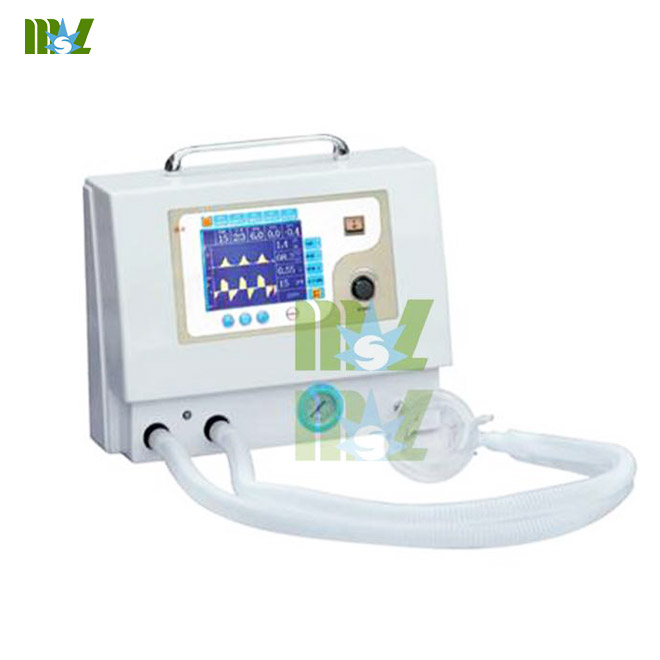A medical ventilator (or simply ventilator in context) is a machine designed to mechanically move breathable air into and out of the lungs,to provide the mechanism of breathing for a patient who is physically unable to breathe,or breathing insufficiently.
While modern ventilators are computerized machines,patients can be ventilated with a bag valve mask,a simple hand-operated bag-valve mask.
Ventilators are chiefly used in intensive care medicine,home care,and emergency medicine (as standalone units) and in anesthesia (as a component of an anesthesia machine).
Medical ventilators are sometimes colloquially called "respirators," a term which stems from commonly used devices in the 1950s (particularly the "Bird Respirator").However,in modern hospital and medical terminology,these machines are never referred to as respirators,and use of "respirator" in this context is now a deprecated anachronism which signals technical unfamiliarity.

Function
In its simplest form,a modern positive pressure ventilator consists of a compressible air reservoir or turbine,air and oxygen supplies,a set of valves and tubes,and a disposable or reusable "patient circuit".The air reservoir is pneumatically compressed several times a minute to deliver room-air,or in most cases,an air/oxygen mixture to the patient.If a turbine is used,the turbine pushes air through the ventilator,with a flow valve adjusting pressure to meet patient-specific parameters.When overpressure is released,the patient will exhale passively due to the lungs' elasticity,the exhaled air being released usually through a one-way valve within the patient circuit called the patient manifold.The oxygen content of the inspired gas can be set from 21 percent (ambient air) to 100 percent (pure oxygen).Pressure and flow characteristics can be set mechanically or electronically.
Ventilators may also be equipped with monitoring and alarm systems for patient-related parameters (e.g.pressure,volume,and flow) and ventilator function (e.g.air leakage,power failure,mechanical failure),backup batteries,oxygen tanks,and remote control.The pneumatic system is nowadays often replaced by a computer-controlled turbopump.
Modern ventilators are electronically controlled by a small embedded system to allow exact adaptation of pressure and flow characteristics to an individual patient's needs.Fine-tuned ventilator settings also serve to make ventilation more tolerable and comfortable for the patient.In Canada,and the United States,respiratory therapists are responsible for tuning these settings while biomedical technologists are responsible for the maintenance.
The patient circuit usually consists of a set of three durable,yet lightweight plastic tubes,separated by function (e.g.inhaled air,patient pressure,exhaled air).Determined by the type of ventilation needed,the patient-end of the circuit may be either noninvasive or invasive.
Noninvasive methods,which are adequate for patients who require a ventilator only while sleeping and resting,mainly employ a nasal mask.Invasive methods require intubation,which for long-term ventilator dependence will normally be a tracheotomy cannula,as this is much more comfortable and practical for long-term care than is larynx or nasal intubation.
Life-critical system
Because the failure of a mechanical ventilation system may result in death,it is classed as a life-critical system,and precautions must be taken to ensure that mechanical ventilation systems are highly reliable.This includes their power-supply provision.
Mechanical ventilators are therefore carefully designed so that no single point of failure can endanger the patient.They may have manual backup mechanisms to enable hand-driven respiration in the absence of power (such as the mechanical ventilator integrated into an anaesthetic machine).They may also have safety valves,which open to atmosphere in the absence of power to act as an anti-suffocation valve for the spontaneously breathing patient.Some systems are also equipped with compressed-gas tanks,air compressors,and/or backup batteries to provide ventilation in case of power failure or defective gas supplies,and methods to operate or call for help if their mechanisms or software fail.
We Guangzhou Medsinglong Medical Equipment Co., Ltd is specifically do breathing machine manufacturer,if you have any needs or questions,please contact:cindy@medicalequipment-msl.com
Related Posts
How Does a Ventilator Work?
Ventilators blow air—or air with extra oxygen—into the airways and then the lungs......
What Is a Ventilator
A ventilator (VEN-til-a-tor) is a machine that supports breathing......
- Home
- All Products
- Ultrasound
- Lab Equipment
- Blood cell analyzer
- Automated blood analyzer
- Biochemistry analyzer
- Veterinary blood analyzer
- Urine Analyzer
- Mindray analyzer
- Rayto IVD
- Blood gas analyzer
- Portable blood analyzer
- Blood coagulation analyzer
- Blood pressure analyzer
- Blood lactate measurement
- Handheld blood analyzer
- Microplate readers
- Testing equipment
- Surgery
- Beauty Equipment
- Vet equipment
- X rays
- Contact MSL




 Price is 8-20% Lower Than Other
Price is 8-20% Lower Than Other






